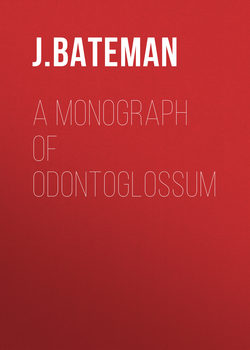A Monograph of Odontoglossum

Реклама. ООО «ЛитРес», ИНН: 7719571260.
Оглавление
J. Bateman. A Monograph of Odontoglossum
INTRODUCTION
Plate I. ODONTOGLOSSUM NEBULOSUM, Lindley
Plate II. ODONTOGLOSSUM URO-SKINNERI, Lindl
Plate III. ODONTOGLOSSUM PHALÆNOPSIS, Rchb. fil
Plate IV. ODONTOGLOSSUM INSLEAYI, Lindl
Plate V. ODONTOGLOSSUM PESCATOREI, Lindley
Plate VI. ODONTOGLOSSUM PENDULUM
Plate VII. ODONTOGLOSSUM HASTILABIUM, Lindley
Plate VIII. ODONTOGLOSSUM GRANDE, Lindley
Plate IX. ODONTOGLOSSUM NÆVIUM, Lindley
Plate X. ODONTOGLOSSUM CARINIFERUM, Reichb. fil
Plate XI. ODONTOGLOSSUM LINDLEYANUM
Plate XII. ODONTOGLOSSUM GLORIOSUM
Plate XIII. a. ODONTOGLOSSUM WARNERIANUM,
Plate XIII. b. ODONTOGLOSSUM STELLATUM
Plate XIV. ODONTOGLOSSUM ALEXANDRÆ
Plate XV. ODONTOGLOSSUM REICHENHEIMII
Plate XVI. ODONTOGLOSSUM LÆVE
Plate XVII. ODONTOGLOSSUM LUTEO-PURPUREUM
Plate XVIII. ODONTOGLOSSUM BICTONIENSE
Plate XIX. ODONTOGLOSSUM ALEXANDRÆ
Plate XX. ODONTOGLOSSUM MACULATUM
Plate XXI. ODONTOGLOSSUM HALLII
Plate XXII. ODONTOGLOSSUM ROSEUM
Plate XXIII. ODONTOGLOSSUM TRIUMPHANS
Plate XXIV. ODONTOGLOSSUM KRAMERI
Plate XXV. ODONTOGLOSSUM CORDATUM
Plate XXVI. ODONTOGLOSSUM ANGUSTATUM
Plate XXVII. ODONTOGLOSSUM CORONARIUM
Plate XXVIII. ODONTOGLOSSUM BLANDUM
Plate XXIX. ODONTOGLOSSUM VEXILLARIUM
Plate XXX. ODONTOGLOSSUM ROEZLII
Отрывок из книги
O. (Leucoglossum, Lindl.) pseudobulbis ovatis compressis 2-3-phyllis, foliis oblongis acutis basi conduplicatis pedunculo radicali erecto (apice) nutante 3-7-floro brevioribus, bracteis scariosis amplexicaulibus ovario duplo brevioribus, sepalis petalisque latioribus membranaceis oblongis undulatis apiculis recurvis, labelli ungue cucullato carnoso, lamellis duabus erectis dentibusque totidem anticis, limbo ovato acuto dentato subpubescente, columnâ apterâ elongatâ. (Lindl. quibusdam mutatis.)
Odontoglossum nebulosum, Lindl. Fol. Orch.
.....
It was at Munich, in the year 1835, that I first became acquainted with this fine Odontoglossum having, through the kindness of Professor Von Martius, been allowed to examine the rich collection of dried specimens that Baron Karwinski had then recently brought home with him from Mexico. Two years afterwards living plants were sent to me from Oaxaca, which happening to arrive in the midst of that remarkably severe winter 1837-38, I naturally expected would have been destroyed on their way; so far, however, from this being the case, they appeared to have sustained little or no injury from the cold, and on being placed in a stove they soon began to push both roots and leaves. All went well so long as the temperature of the house did not exceed 70°, but when the winter had passed away and they had to face the intense heat at which the Orchid-houses of that period were ordinarily maintained, they then quickly lost their vigour and before a twelvemonth had passed were all gone, victims – like a multitude of other invaluable plants – to our then ignorance of the conditions under which alone the Orchids of cool countries could be expected to thrive!
I am not aware that this plant ever flowered in this country until within the last year or two, certainly no figure of it has ever been published in any English botanical periodical; I have, however, found in a French work (the Illustration Horticole), under the name of O. maxillare, what is obviously the same as the plant represented in the Plate. I should myself have probably fallen into the same mistake as Professor Lemaire, had I not enjoyed the opportunity – which he unfortunately had not – of examining the original specimens in Dr. Lindley's herbarium, and from which that able botanist drew up his description (in the Folia Orchidacea) of the two species. O. maxillare, of which Dr. Lindley only examined a single flower – though he made a most careful drawing – is shown by a glance at the latter, to be a totally different thing; it has moreover, I fear, long since disappeared from our collections. In Dr. Lindley's description the flower-scape is said to be terminal, which in nature it never is, although from the way in which Karwinski's wild specimen was glued together, it certainly presents that appearance in the herbarium. The column moreover, and the base of the sepals and petals, are said to be pubescent, though nothing of the kind is visible to the naked eye when the flowers are fresh. With a powerful magnifying glass pubescence may certainly be seen.
.....